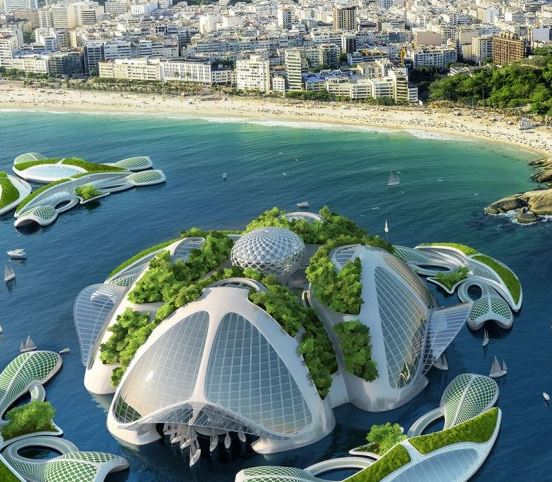Belgian architect, Vincent Callebaut, has designed an underwater village called Aequorea with skyscrapers, which he describes as a self-sufficient non-polluting eco-village where almost everything is located below the surface of the sea. Mr. Callebaut is famous globally for his eco-friendly designs.
He describes this city in an unusual way. He explains it in a fictional letter written by a 15-year old boy called Océane on Christmas Eve in the year 2065. He is an aquanaut teen, born underwater in 2050 in Aequorea, an underwater farm off the coast of Rio de Janeiro, Brazil.
The farm, or town – by then both are the same – draws its name from the bioluminescent light-emitting jellyfish Aequorea, sometimes called Crystal Jelly, with articulated, webbed tentacles. Thanks to its tentacles the jellyfish can swim, while it produces its own energy.
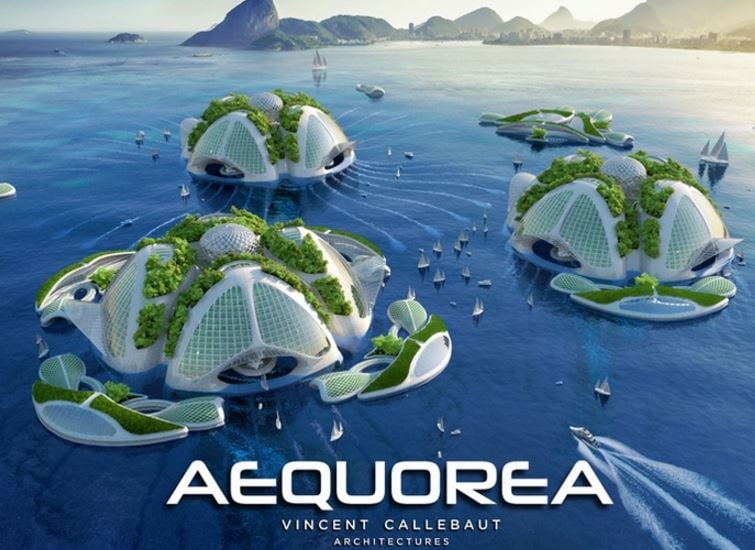 Aequorea, the underwater eco-friendly village in 2065. (Image: vincent.callebaut.org)
Aequorea, the underwater eco-friendly village in 2065. (Image: vincent.callebaut.org)
The jellyfish is best known as the source of two proteins involved in bioluminescence – aequorin and green fluorescent protein (GFP). Osamu Shimomura and colleagues won the 2008 Nobel Prize in Chemistry for their work on GFP.
Eco-village the result of the boy’s grandparents’ efforts
The boy’s grandparents, both architects and oceanographers, have spent the last 50 years participating in the first collaborative construction of the underwater village.
Océane writes:
“It’s a genuine underwater village printed in 3D from algoplast, a composite material they invented that mixes algae with garbage from the 7th continent. You know, the 7th continent? That infamous soup of plastics formed at the beginning of the century in the heart of the five main ocean gyres, where the Coriolis effect causes the currents to swirl.”
“In the 20th Century, on Earth, every human being was producing up to ten times their weight in garbage annually. Two hundred and sixty-nine million tons of plastic waste with a life expectancy of a thousand years were thus produced every single year, and more than 10% of it were ending up in the oceans.”
According to his grandmother, this 7th continent, made of garbage, being located in international waters did not belong to any state. No head of state would commit resources to cleaning up those millions of tons of plastic waste trapped by the sea currents in the heart of their vortex.
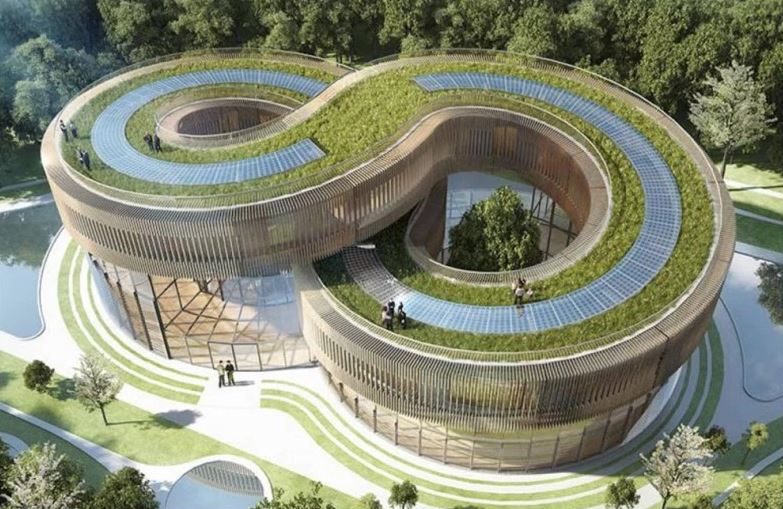 Vincent Callebaut is famous for designing futuristic buildings and cities. The one above is called ‘Orchards’, and was designed as a farm city in China. (Image: aasarchitecture.com)
Vincent Callebaut is famous for designing futuristic buildings and cities. The one above is called ‘Orchards’, and was designed as a farm city in China. (Image: aasarchitecture.com)
Oceans became our dumping ground
She told him the oceans, which cover 71% of our beautiful blue planet, had become humanity’s dumping ground.
His grandparents, together with like-minded scientists from across the world, decided to extract value from this revolting soup of petroleum-based waste by recycling it. They formed an NGO (non-governmental organization) to encourage an ethical approach to the oceans.
Aboard their bizarre ships, inspired from the Klein bottle, they set about sorting and crushing bottles, bags, cans and other types of packaging into granules. Microparticles suspended at depths of 30 to 100 feet were filtered.
Inside floating workshops and fabrication laboratories (fab labs) they mixed this raw material with a gelling algae emulsion, to extrude it in the form of eco-friendly filaments. 3-D architectural printers used those reels of eco-friendly filaments to reinvent naval constructions. Fabrication, in this context, means ‘manufacturing.’
By 2015, they started repurposing plastic waste dumped by land-dwelling people (People of the Land) into impervious, durable materials.
 Mr. Callebaut’s design called Solar Drop – located at the end of a long breakwater off the coast of Abu Dhabi. (Image: arch2o.com)
Mr. Callebaut’s design called Solar Drop – located at the end of a long breakwater off the coast of Abu Dhabi. (Image: arch2o.com)
Consuming a city like a commodity rather than a common good
The 15-year old boy writes:
“When my grandfather tells me about his terrestrial way of life of the time, it seems totally preposterous today. The People of the Land, those supposedly, self-proclaimed Homo Sapiens, took two centuries to understand that they were living on finite territory with limited natural resources.”
“They were consuming the city like a commodity, rather than a common good that should be nurtured in symbiosis with nature. They were suffocating from inhaling urban smogs, the infamous photochemical clouds caused by pollution.”
“Without knowing it, they were ingesting plastic infesting the food chain. And because of overfishing, they had almost emptied the supply of fish in the oceans. In this December month of 2065, it’s still hard for me to believe how carelessly the People of the Land mortgaged the fate of future generations.”
Since the 2015 Climate Change Summit in Paris (COP21) and the Marrakech summit a year later (COP22), tensions between the rich nations and the African countries rose. The rich nations did not want the African countries to reproduce the fossil-fuel-based energy models they had used to get rich. Fortunately, the Archibiotic boom changed everything.
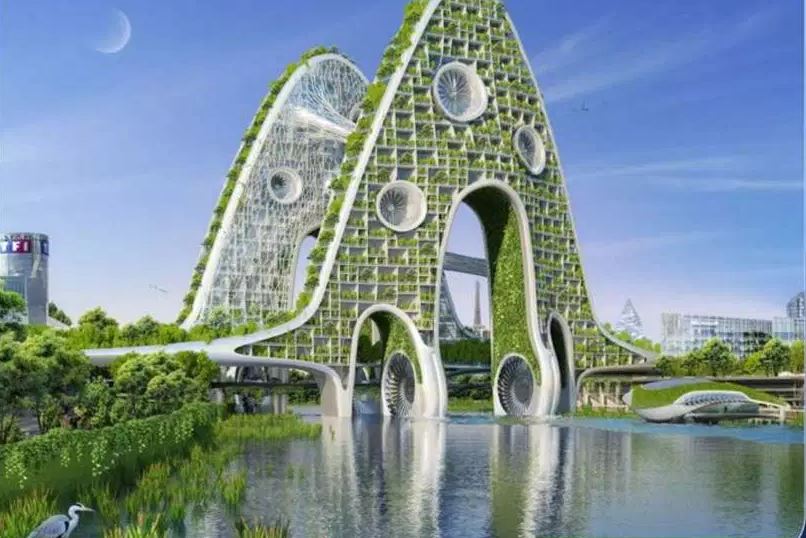 Future Paris, a green inhabited amphibian bridge across the Seine river, designed by by Vincent Callebaut Architectures. (Image: aasarchitecture.com)
Future Paris, a green inhabited amphibian bridge across the Seine river, designed by by Vincent Callebaut Architectures. (Image: aasarchitecture.com)
Archibiotic refers to a new kind of transdiciplinary Eco-concept aimed at creating new cities and intelligent buildings.
This biomimetic kind of architecture – using advanced renewable energies alongside information and communication technologies (NTIC) – eventually offered energy security (independence) to each of the world’s nations. Consequently, oil conflicts gradually dissipated.
Rising sea levels and the ‘People of the Seas’
Climate change meant rising sea levels, which spurned a new civilization – the People of the Seas. As soon as their islands and lands were covered with water and salinized, a sizeable portion of the 250 climate refugees became involved with interdependent NGOs, much like the one his grandparents founded.
Everybody got together and new underwater urbanization processes that were energy self-sufficient were created – all waste was recycled.
What was the aim of the People of the Seas? They wanted to explore the super-deep part of the oceans in a respectful way, in order to accelerate innovation and make new renewable energies available to everybody.
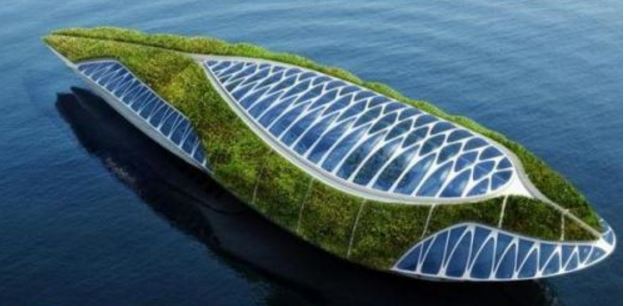 Physalia – a huge floating garden by Vincent Callebaut. (Image: homedit.com)
Physalia – a huge floating garden by Vincent Callebaut. (Image: homedit.com)
The People of the Seas fought the capitalist frenzy bent on plundering the last of the petroleum left on the planet, as well as methane resources, by drilling and fracking habitats at great depths (in the oceans).
At first, the People of the Seas were ridiculed as a bunch of nutcases. Most people were more attracted by the idea of migrating to Mars after having exhausted the Earth of all its resources.
The People of the Seas eventually got there
However, over the last fifty years, the People of the Seas managed to revolutionize how we live together, through intensive energy transition and environmental resilience.
They managed to recycle 100% of the 7th continent’s plastics into a sustainable habitat.
The boy continues:
“Since then, the Aequoreas continue to self-build through eco-friendly, natural calcification, in the same way sea shells do – by fixing the calcium carbonate contained in water to form an external skeleton.”
“These are genuine blue carbon wells shaped like twisted towers 1000 meters (3280 feet) deep. By using aragonite (which has a high carbon component) as the construction material for its transparent façades, an Aequorea can fix 2,500 tons of additional CO2 per square kilometer (250 acres) annually.”
Each underwater village can welcome up to 20,000 people or aquanauts. Their main access is on the surface of the water, through four marinas covered with mangrove plants that grow on a 500-metre (1640 feet) wide floating dome.
 Vincent Callebaut is a Belgian architect famous for his eco-friendly projects. He has received many awards. (Image: vincent.callebaut.org)
Vincent Callebaut is a Belgian architect famous for his eco-friendly projects. He has received many awards. (Image: vincent.callebaut.org)
Underwater multi-layered villages
Each village has co-working spaces, science labs, educational hotels, sports fields, recycling plants, phyto-purification, and aquaponic farms, stacked up in several layers.
The twisting towers are designed to withstand marine whirlpools and hydrostatic pressure. Their double shell allow for ballasting. Once the ballasts are filled with seawater, the Aequorea’s centre of gravity is lowered, thus eliminating the buoyancy effect.
Whenever there is a storm or earthquake, the towers remain stable. The double shell gets thicker the further down you go, which compensates for the strain caused by the increase in water pressure.
The People of the Sea no longer use scuba tanks to breathe under water. They wear gill masks, which capture water and extract oxygen molecules, plus a microbead suit which is just like a dolphin’s skin. Their underwater swimming outfit also includes fiber monofins, which were inspired by whale tails.
Non-polluting air-purification and energy sources
These underwater villages no longer rely on nuclear, oil, gas, or coal to produce light. Bioluminescence is reproduced in the double glazing of the inhabitants’ apartments, thanks to symbiotic organisms that contain luciferin, a light-emitting compound that is activated through oxidation.
Sea currents are used to produce electricity. A field of water turbines shaped like volutes (spiral shells) are laid out on the ocean floor in a star pattern around an scientific base.
Further electrical energy is produced at an ocean thermal energy conversion (OTEC) power plant. It uses the difference in temperature between the cool water deep down and the warm surface water to produce continuous energy.
The OTEC power plant produces drinking and aquaculture water by using the in-depth pressure to counteract the osmotic pressure, and to separate the salt from water via a semipermeable membrane.
Air is renewed either via seawater electrolysis or by convection through wind chimneys innervating the four branches of each tower’s twist.
Microalgae grown in aquarium walls are used for heating and climate control. They absorb CO2 produced when people breathe. These green-algae-based bioreactors also recycle solid and liquid organic waste, and produce energy through biomethanation (formation of methane by microbes known as methanogens) and photosynthesis.
Innovative food supply
The inhabitants food supply comes from the plankton, algae and mollusks, which are rich in vitamins, proteins and minerals. Coral reefs are cultivated on balconies, and also become nurseries for aquatic fauna and flora.
On the water’s surface, four large floating shell-like structures house organic farming fields, orchards, vegetable gardens, and horticultural greenhouses.
The inhabitants live from sustainable fishing in their apartments’ garden – the ocean. The word ‘packaging’ no longer exists in their dictionary. All their food is distributed in bulk, in biodegradable and reusable containers.
Transport is done with submarines or ships, which are propelled with algae fuel or hydrocarbons they produce free of greenhouse gas emissions.
Hydrogen and carbon are extracted from seawater through osmotic pressure, and are then synthesized into biofuels. This process allows them to pump the CO2 out of the oceans, thus preventing its acidification.
They study the molecules of living organisms to heal themselves. Studies with starfish have helped them understand the multiplication of cancer cells. Thanks to the herring, they developed the first therapy to fight AIDS. By decrypting how the heart of the humpback whale works, they have invented a new generation of pacemakers.
Bio-based material are only used to lay out and furnish their apartments. They are assembled using an eco-friendly glue synthesized by isolating the protein of a mussel.
A totally new economic model
The boy’s letter ends as follows:
“Oh, I almost forgot to tell you about the most important change! We went through a real economic Big Bang, because we also created a currency specific to marine urbanism: the Aequo. In 2050, just before I was born, my parents voted in favor of a referendum for a bill to implement the universal revenue.”
“In this vertical village, the economy is horizontal! No more bosses! No more employees! We’re now all eco-conscious individual entrepreneurs. We’ve become actors of a blue, fair, circular and interdependent economy again. Man and nature are back at the heart of all concerns. We didn’t save capitalism, but we keep saving the climate!”
“Never forget this: oceans produce 50% of our planet’s oxygen. They are its most active lung! It was really worth cleaning them, and fighting their acidification, thus re-enchanting our living together — don’t you think?”
Video – Lilypad, a city floating on water
In future, could humans live on water if needed? Architect Vincent Callebaut has envisioned an innovative solution. His futuristic concept, which he calls ‘Lilypad’ would essentially allow a city to reside on water. Up to 50,000 people could live in each city.

